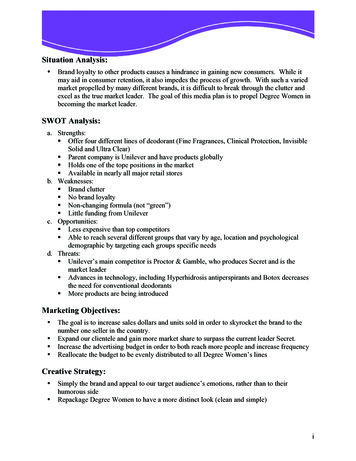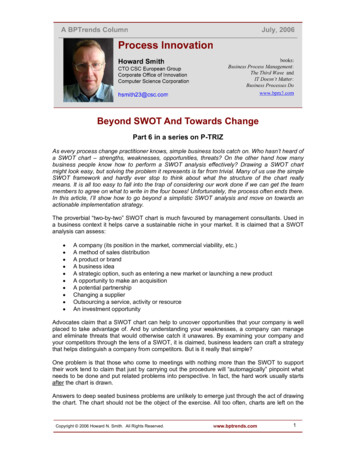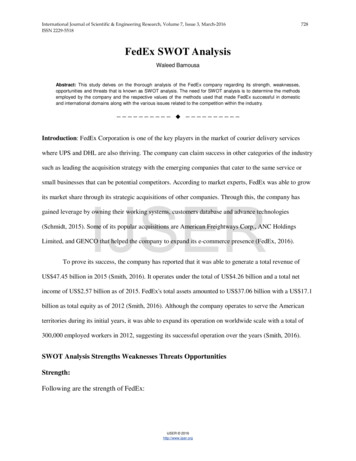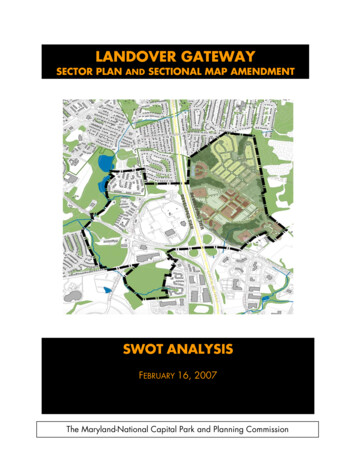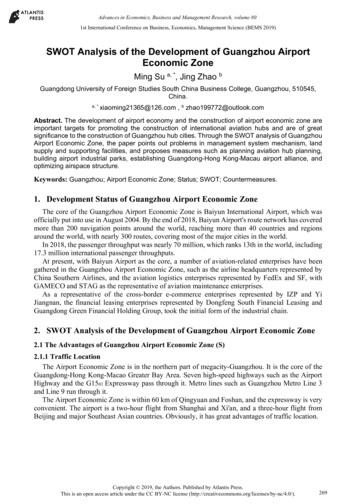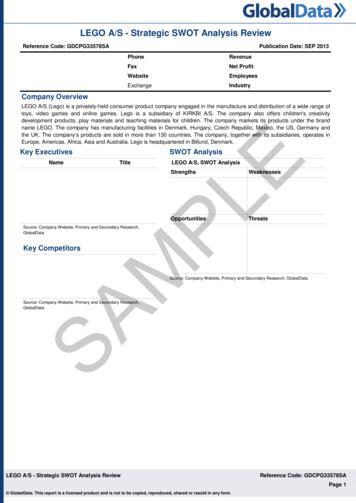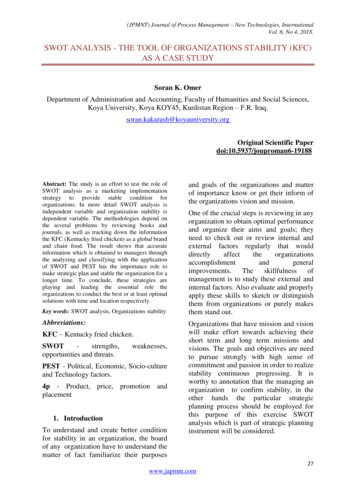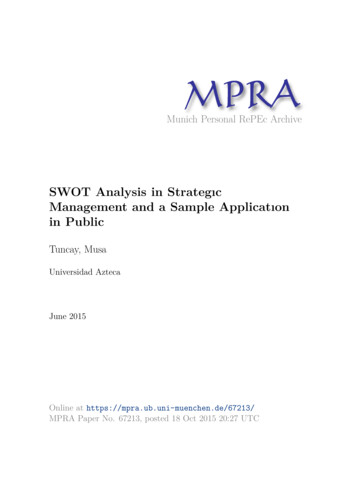
Transcription
Munich Personal RePEc ArchiveSWOT Analysis in StrategıcManagement and a Sample Applicatıonin PublicTuncay, MusaUniversidad AztecaJune 2015Online at https://mpra.ub.uni-muenchen.de/67213/MPRA Paper No. 67213, posted 18 Oct 2015 20:27 UTC
SWOT Analysis in Strategıc Management and aSample Applicatıon in PublicMusa Tuncay1ABSTRACTIn the face of rapid change and increasing competition all over the world, StrategicManagement has begun to gain importance. Not only in the private sector, considering allorganizations operating in the public and third sector, more strategic thinking and strategicplanning has become more important than before in the face of globalization and competitioncases it brings. The most important feature of strategic management is that it provides theopportunity for an organization to analyze both its own status and the environment outside ofthe organization. Strategic management which is in broad use in the private sector has alsobecome indispensable for public sector. Peculiar purposes of public management present adifferent service understanding as compared to the private sector. Public management generallydoes not have profit purposes in its services and has to draw attention to and solve the socialproblems. This article emphasizes recognition of the importance of the strategic managementin public and defines the important elements of the SWOT (Strengths, Weaknesses,Opportunities, Threats) analysis that must be included within the integrated model of strategicmanagement. A face-to-face citizen expectation questionnaire was conducted with 1500 peopletogether with internal and external stakeholder questionnaires in Eyyübiye district for theStrategic Management of Eyyübiye Municipality, Şanlıurfa and a SWOT(Strengths, Weaknesses,Opportunities, Threats)analysis was established. The purpose of this article is to raise awarenessof the importance of SWOT analysis in strategic management in public.Key Words: Strategic Management, SWOT Analysis, SWOTWHAT IS STRATEGIC MANAGEMENT?Strategic management can be defined as the art and science of formulating,implementing, and evaluating cross-functional decisions that enable an organization to achieveits objectives.As this definition implies, strategic management focuses on g,production/operations,Universidad Azteca Doctora Student / Turkey, E-mail: musa tuncay@yahoo.comresearchand
development, andinformation systems to achieve organizational success. The term strategicmanagement inthis text is used synonymously with the term strategic planning. The latter termis more often used in the business world, whereas the former is often used in academia.Sometimes the term strategic management is used to refer to strategy formulation,implementation, and evaluation, with strategic planning referring only to strategy formulation.The purpose of strategic management is to exploit and create new and different opportunitiesfor tomorrow; long-range planning, in contrast, tries to optimize for tomorrow the trends oftoday. The term strategic planning originated in the 1950s and was very popular between themid-1960s and the mid-1970s. During these years, strategic planning was widely believed to bethe answer for all problems. At the time, much of corporate America was “obsessed” withstrategic planning. Following that “boom,” however, strategic planning was cast aside during the1980s as various planning models did not yield higher returns. The 1990s, however, brought therevival of strategic planning, and the process is widely practiced today in the business world. Astrategic plan is, in essence, a company’s game plan. Just as a football team needs a good gameplan to have a chance for success, a company must have a good strategic plan to competesuccessfully. Profit margins among firms in most industries have been so reduced by the globaleconomic recession that there is little room for error in the overall strategic plan. A strategicplan results from tough managerial choices among numerous good alternatives, and it signalscommitment to specific markets, policies, procedures, and operations in lieu of other, “lessdesirable” courses of action (Fred, 2011).Strategic management consists of the analysis, decisions, and actions an organizationundertakes in order to create and sustain competitive advantages. This definition captures twomain elements that go to the heart of the field of strategic management. First, the strategicmanagement of an organization entails three ongoing processes: analysis, decisions, andactions. That is, strategic management is concerned with the analysis of strategic goals(vision,mission, and strategic objectives) along with the analysis of the internal and externalenvironment of the organization. Next, leaders must make strategic decisions. These decisions,broadly speaking, address two basic questions: What industries should we compete in? Howshould we compete in those industries? These questions also often involve an organization’sdomestic as well as its international operations. And last are the actions that must be taken.Decisions are of little use, of course, unless they are acted on. Firms must take the necessaryactions to implement their strategies. This requires leaders to allocate the necessary resourcesand to design the organization to bring the intended strategies to reality. As we will see in thenext section, this is an ongoing, evolving process that requires a great deal of interaction among
these three processes. Second, the essence of strategic management is the study of why somefirms outperform others. Thus, managers need to determine how a firm is to compete so that itcan obtain advantages that are sustainable over a lengthy period of time. That means focusingon two fundamental questions: How should we compete in order to create competitiveadvantages in the marketplace? For example, managers need to determine if the firm shouldposition itself as the low-cost producer, or develop products and services that are unique whichwill enable the firm to charge premium prices-or some combination of both.( Dess,Gregory,Lumpkin and Taylor, 2005.)An academic field is a socially constructed entity (Hagstrom, 1965; Kuhn, 1962). Incomparison to a formal organization, which can be identified and defined, for instance, by itsweb of legal contracts (Williamson, 1979), an academic field has socially negotiated boundariesand only exists if a critical mass of scholars believe it to exist and adopt a shared conception ofits essential meaning (Astley, 1985; Cole, 1983). Such shared meaning is far from assured,however, since various forces can serve to dilute or blur consensus. These forces might includeheterogeneity of members’ trainin the intellectual pull and hegemony of adjacent fields, and anever-shifting body of knowledge and theory (Astley, 1985; Whitley, 1984).Strategic management represents a case of an academic field whose consensual meaningmight be expected to be fragile, even lacking. The field is relatively young, having been abruptlyreconceptualized and relabeled—from ‘business policy’—in 1979 (Schendel and Hofer, 1979).Its subjects of interest overlap with several other vigorous fields, including economics, sociology,marketing, finance, and psychology (Hambrick, 2004), and its participant members have beentrained in widely varying traditions—some in economics departments, some in strategicmanagement departments, some in organizational behavior, some in marketing, and so on. Itcomes as little surprise, then, that the published, espoused definitions of strategic managementvary (as we shall review below). And we can anticipate that asking strategic managementscholars to define the field might elicit an array of responses. How, then, does the field ofstrategic management maintain its collective identity and distinctiveness? The answer, weanticipate, is that there is a strong implicit consensus about the essence of the field, even thoughthere may be ambiguity about its formal definition. This paradox is reminiscent of the fabledquote of U.S. Supreme Court Justice Potter Stewart: ‘I’m not sure how to define pornography,but I know it when I see it’ (Jacobellis v. Ohio, 378 U.S. 184, 1964).Stewart’s legendary remark captures a fundamental challenge facing the young, rapidlyexpanding field of strategic management. Exactly what is it? There is a substantial need for
discourse and reflection regarding the very nature of the field; scholars—especially youngscholars—need analytic signposts to help them understand the scope and meaning of the field.What does it mean to be doing research in strategic management? What does it take to be seenas a strategic management scholar? While prior analyses have examined the rise and fall ofspecific theories or research topics within strategic management ( Hoskisson, 1999; RamosRodriguez and Ruiz-Navarro, 2004), in this paper we pursue a more fundamental objective: toidentify the consensus definition—both implicit and explicit—or the very meaning of the field.Since 1979, when Schendel and Hofer (1979) rechristened the field of business policy asstrategic management and proposed a new paradigm centered on the concept of strategy,scholars have conducted numerous analyses of the field.1 These works primarily haveattempted to examine the intellectual ebbs and flows, research trends, and theoreticalperspectives of the field (Rumelt, Schendel, and Teece, 1994; Saunders and Thompson, 1980;Schendel and Cool, 1988). Among these various assessments, for instance, Hoskisson et al.(1999) traced the pendulum-like swings in the field’s emphasis on firms’ external environmentsand internal resources. Summer et al. (1990) analyzed the historical progression and status ofdoctoral education in the field. Recently, RamosRodriguez and Ruiz-Navarro (2004) used citationanalysis to chart the intellectual progression of the fieldAs important as all these prior analyses have been, they have omitted any attention to afundamental question: just what is strategic management? The field’s lack of interest inaddressing this basic question is noteworthy for two reasons. First, the field’s identity, by its verynature, is ambiguous and highly contestable (Hambrick, 1990; Spender, 2001). It intersects withseveral other well-developed fields, including economics,marketing, organizational theory,finance, and sociology (Bowman, Singh, and Thomas, 2002); without a clear sense of collectiveidentity and shared purpose, strategic management is vulnerable to intellectual and practicalattack (in terms, say, of resources, journal space, and tenure slots) from these other fields.Lack of attention to the essence of the field is noteworthy for a second reason: theformally espoused, published definitions of the field are quite varied. The Appendix presents aselected set of definitions, including Learned et al.’s (1965) definition of the precursor field:business policy.2 The definitions range widely. Some refer to general managers (Fredrickson,1990; Jemison, 1981; Schendel and Cool, 1988), while others do not. Some indicate the overallorganization or firm as the relevant unit of analysis (e.g., Learned et al., 1965), while others donot. Some refer to the importance of organizational performance or success (Bowman et al.,2002; Rumelt et al., 1994; Schendel and Hofer, 1979), some to external environments (e.g.,
Bracker, 1980; Jemison, 1981), some to internal resources (e.g., Bracker, 1980; Jemison, 1981),some to strategy implementation (Van Cauwenbergh and Cool, 1982), and some refer to noneof these (e.g., Smircich and Stubbart, 1985)SWOT ANALYSIS:SWOT stands for: Strength, Weakness, Opportunity, and Threat. A SWOT analysis guidesyou to identify your organization’s strengths and weaknesses (S-W), as well as broaderopportunities and threats (O-T). Developing a fuller awareness of the situation helps with bothstrategic planning and decision-making.The SWOT method was originally developed for businessand industry, but it is equally useful in the work of community health and development,education, and even for personal growth (University of Kansas, 2014).SWOT is a strategic planning method used to evaluate the Strengths, Weaknesses,Opportunities, and Threats involved in a project, organization, or in a business venture. Strengths are aspects or characteristics of the business, or project teams that give it anadvantage over others; Weaknesses are aspects or characteristics that place the organization at a disadvantagerelative to others; Opportunities are internal and external prospects that can improve organization’sperformance within the context; Threats are internal and external influencing factors in the environment that could causetrouble for the function or project. SWOT focuses on internal and external factors.- Internal factors may include: Personnel, finance, fundraising capabilities, andboard performance, etc.- External factors may include: Economic climate, technological changes,legislation, social culture changes, competitors, etc. SWOT can be used in business corporations, governmental departments, and nonprofitorganizations. SWOT can be performed for business planning, strategic planning, competitorevaluation, marketing development, and research reports (Quincy, Lu and Huang, 2012)
From the whole process of strategic planning, SWOT analysis is the early but veryimportant step in the area of strategic analysis, as Pashiardis (1996) commented, ‘environmentalscanning is essential for an effective planning. One needs to know the environment in which oneoperates before making any decisions about the organization, so as to be able to match one’scapabilities with the environment in which the organization operates.’ SWOT consists of twomain parts: the analysis of the internal situation (strengths and weaknesses) and the analysis ofthe external environment (opportunities and threats). It is important to note that the externale
Sometimes the term strategic management is used to refer to strategy formulation, implementation, and evaluation, with strategic planning referring only to strategy formulation. The purpose of strategic management is to exploit and create new and different opportunities for tomorrow; long-range planning, in contrast, tries to optimize for tomorrow the trends of today. The term strategic .
